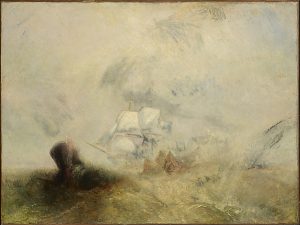American Renaissance
The advent of a national literary consciousness in the United States is generally attributed to the American Renaissance period, from around 1830 to the beginning of the Civil War. Prior to this period, much of American Literature was serialized in periodicals, rather than as cohesive publications. As publishing companies began to take hold in the States, there was a influx of print journalism and new literary works. Two of the most popular genres to come from this period was Transcendentalism, with authors such as Ralph Waldo Emerson and Henry Thoreau, or Dark Romanticism, favored by Edgar Allen Poe, Nathaniel Hawthorne and Herman Melville. Transcendentalists often had a more optimistic tone to their work than Dark Romanticists, but both factions focused on themes of nature, spirituality and separation from civilization.
Despite sharing membership in the American Renaissance with Transcendentalists, Dark Romanticists took a more pessimistic view of human nature, writing narratives characterized by destruction and sin. Poe, Hawthorne, and Melville, authors of the genre, often corresponded with one another. This led to a more cohesive body of literature with shared themes. Dark Romanticist authors tended to be critical of reformers, including those of the Transcendentalist movement. Though Herman Melville supported activism such as prison reform, he did not share the more optimistic views of Transcendentalists. In Melville’s “Bartleby the Scrivener,” the title character constantly repeats the phrase “I would prefer not to,” (Melville 1489) eventually becoming jailed and dying alone because of his abstinence. While critics disagree about interpretation, Bartleby’s unpleasant end could be perceived as a dig towards Henry David Thoreau, who chose to abstain from taxes as an activist gesture. Similarly, both Poe and Hawthorne wrote works criticizing Transcendentalists.
Nature was a popular theme in the American Renaissance, favored by Transcendentalists as well as Dark Romanticists. Contrary to the spiritual, positive view of nature in Transcendentalism, these authors illustrated nature as ominous and powerful. In Nathaniel Hawthorne’s stories, he portrayed the woods as a dark force. The woods represent Hawthorne’s view of human nature: unpredictable and difficult to understand. In Hawthorne’s “Young Goodman Brown”, the woods reveal the true actions of the Puritan community, exposing religious corruption. Similarly, Poe utilizes natural surroundings to contribute to the gothic atmosphere. With The Fall of the House of Usher, Poe establishes the mood of the work by painting a vivid picture of how the surrounding nature’s darkness has bled into the mansion itself. Melville’s “Moby Dick” portrayed how weak man is in comparison with the forces of nature.

Furthermore, these authors wrote their protagonists as flawed individuals prone to sin and destruction. Their works acted as a foil to the more optimistic bent of Transcendentalist literature. Traits such as hubris, cruelty and hypocrisy are common in Dark Romanticist characters such as Hawthorne’s Goodman Brown, Poe’s Montresor, or Melville’s Captain Ahab. Often their narratives end unhappily as a result of the protagonist’s actions. In Nathaniel Hawthorne’s “Young Goodman Brown”, the narrator’s choice to commit a sin opens his eyes to the sinfulness of those around him. He becomes mistrustful of everyone and allows this knowledge to affect his life so completely that even “his dying hour was gloom” (Hawthorne 395). Many characters die or are irreparably changed by the end of Dark Romanticist literature.
While Transcendentalists and Dark Romanticists both published narratives in the American Renaissance, Dark Romanticists presented a much more cynical take on comparable topics. Authors such as Edgar Allen Poe, Nathaniel Hawthorne, and Herman Melville were critical of reformers, depicted nature as a dangerous force, and wrote characters that were prone to destructive behavior. Their contributions to the American Renaissance created a rich and diverse national literary consciousness.
Works Cited
Hawthorne, Nathaniel. “Young Goodman Brown.” Ed. Nina Baym, Ed. Robert S. Levine. The Norton Anthology
of American Literature, Volume B. New York: W.W. Norton & Company, Inc., 2012. 386-395. Print.
Melville, Herman. “Bartleby, the Scrivener.” Ed. Nina Baym, Ed. Robert S. Levine. The Norton Anthology
of American Literature, Volume B. New York: W.W. Norton & Company, Inc., 2012. 1483-1509. Print.
Melville, Herman. “Moby Dick.” Ed. Nina Baym, Ed. Robert S. Levine. The Norton Anthology of American
Literature, Volume B. New York: W.W. Norton & Company, Inc., 2012. 1440-1483. Print.
Poe, Edgar Allen. “The Cask of Amontillado.” Ed. Nina Baym, Ed. Robert S. Levine. The Norton Anthology
of American Literature, Volume B. New York: W.W. Norton & Company, Inc., 2012. 714-719. Print.
Turner, Joseph Mallord William. Whalers. 1845. Oil on canvas. Metropolitan Museum of Art, New York, NY.